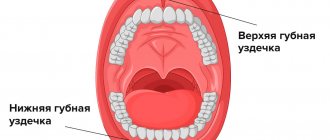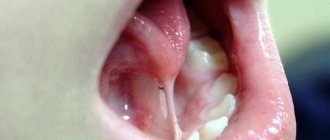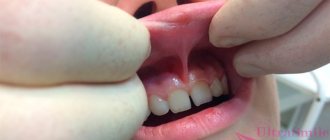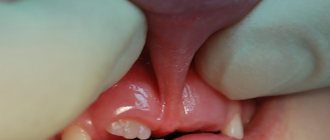When is tongue frenulum trimming required?
The frenulum of the tongue is a small elastic membrane connecting the tongue to the oral cavity. The frenulum is responsible for important functions of the tongue: movement, breathing, swallowing, speech. This disorder is called ankylogloxia.
The normal development of the lingual frenulum begins centrally, at the root of the tongue, and ends at the lower incisors. The rest of the arrangement is a deviation. There are several deviations in the development of the frenulum:
- Short bridle. The tongue becomes inactive and leads to improperly formed speech and jaw deformation.
- Incorrectly positioned frenulum. Reduces motor activity of the tongue.
- Long frenulum under the tongue. It can be located at the tip of the tongue and affect the swallowing process, disrupting nutrition.
Problems with the development of the tongue frenulum are a congenital pathology. And it is hereditary in nature. May occur due to problems during pregnancy.
Trimming the frenulum for an adult
The operation to trim the frenulum of the tongue can be performed at any age as prescribed by a doctor.
Every 20th person has a shortened frenulum of the tongue. The likelihood of this anomaly occurring in men is much higher than in women.
To independently check how the frenulum is located under the tongue, you can do simple children’s exercises: “horse”, “mushroom”, “painter”. Externally, the frenulum will not differ from a healthy state. If you experience any discomfort while performing these exercises, you should go to the clinic for a consultation.
Symptoms that will help you identify problems with tongue webbing:
- When the tongue is extended, the tip of the tongue bends down;
- Difficulty swallowing;
- It is not possible to insert the tongue completely;
- Bite problems;
- Inflammation of the surrounding tissues of the tooth;
- When the tongue is raised, it takes the shape of a heart;
- Incorrect pronunciation of words.
Adults require frenulum trimming less often than small children. However, tissue healing in an adult takes a little longer than in small children. This type of operation is performed under local anesthesia.
When is surgery scheduled?
The frenulum circumcision operation is performed for the following indications:
- Impaired pronunciation of words. If the speech therapist did not notice the deviation in childhood, then speech defects may occur in adulthood. The operation will help restore the functioning of the speech apparatus.
- Orthodontist recommendations. A frenulum that is too short causes crooked teeth and stunts the growth of the lower jaw.
- Periodontal recommendations. Due to deformation of the gums, the root of the tooth is exposed, which makes it susceptible to other diseases.
When not to have surgery
Since all surgical procedures have limitations. If you have:
- acute chronic diseases of the oral cavity;
- benign tumors of the jaw tissue;
- infectious diseases of the whole body;
- poor blood clotting;
- mental disorder;
The operation to trim the frenulum of the tongue is called frenuloplasty.
Types of frenuloplasty
This type of operation can be performed in 3 ways:
- Cutting. The bridle is trimmed, the edges of which are sewn with transverse seams.
- Delete. The frenulum is trimmed using two triangular incisions and removed, after which sutures are applied.
- Moving. The edge of the frenulum is trimmed and secured in the required place with sutures.
The entire operation takes no more than 20 minutes. After a few days, the stitches will dissolve on their own. There are no complications after frenuloplasty.
Why is a short frenulum a problem?
The tongue is limited in movement - what does this lead to? The main problem that is relevant for infants is that the child cannot fully suckle at the breast, he is simply not able to grasp the nipple correctly. The baby cries and turns away from the breast after unsuccessful attempts to get food. The mother's breast, filled with milk, does not empty after the baby is attached. Thus, lactation is not stimulated - milk does not come. As a result, the child is hungry, loses weight, and the woman may experience problems with her breasts: stagnation of milk. As a result, parents have to switch the baby to artificial feeding: it is much easier to suck formula from a bottle, and the incorrect structure of the frenulum is not a hindrance here.
The second problem associated with a shortened hyoid ligament appears in older children - during the period when the child begins to actively master speech, that is, by about 2 years. An incorrect bite may also be associated with a short frenulum. Low tongue mobility makes it difficult to pronounce some sounds: “l”, “r”, “s”. Classes with a speech therapist do not always help. Most likely, the speech therapist will advise correcting the anomaly first.
The fact that the frenulum is shorter than necessary is evidenced by the lower incisors turned in the opposite direction. When a child pulls out the tongue, a specific depression is visible on it. The baby is not able to lick his upper lip or even reach the roof of his mouth with his tongue.
In addition, a short frenulum may prevent your baby from chewing solid foods.
How is the operation of cutting the hypoglossal ligament performed in a newborn?
The operation itself takes only a few seconds, and if done with a laser, there is not even any blood.
The operation is called frenotomy. It is performed by a dental surgeon or a surgeon. The tool is special scissors.
And now important information for those who are thinking about whether to agree to surgery when the child is still small, or to wait. In a newborn, the nerve endings of the gum mucosa have not yet formed. This means that the baby will not feel pain. He will only feel the discomfort of being in an unfamiliar place, firmly fixing the head and the bright light of the lamp. Immediately after the procedure, it is recommended to put the baby to the breast so that he calms down.
Is it possible to do without surgery or have it done later?
The operation is usually recommended to be done right in the maternity hospital to resolve the issue once and for all. But it happens that the pathology is not pronounced and does not interfere with breastfeeding. Sometimes the frenulum feature goes unnoticed for a year, two or more. In this case, the decision is up to the parents. There is no need to rush into the operation: for a child who has already passed the age of infancy, it is a serious stress, anesthesia will be required, and possibly stitches. The postoperative period for older children is more difficult than for infants up to one year old.
It is necessary to consult with a pediatrician, dentist, speech therapist, surgeon, weigh the possible difficulties, and find out if there are any contraindications. Only after this can you decide whether or not to have an operation.
Indications and contraindications for the procedure
Indications:
- Restoring sucking function in infants.
- Speech defects.
- Delayed development of the lower jaw.
- Not chewing food thoroughly.
- Malocclusion.
- Too dense arrangement of teeth or presence of gaps between them.
- Difficulties during orthodontic treatment.
- Preparation for implantation.
Contraindications:
- Poor blood clotting.
- Presence of cancerous tumors.
- Infectious diseases.
- Inflammatory processes in the oral cavity.
- The presence of carious lesions and inflammation of the dental nerve.
If there are problems with breastfeeding, surgery is often performed in the maternity hospital. In older children, the procedure is performed if there are discomfort or problems with diction.
How to stretch
It is necessary to immediately make a reservation that, due to anatomical features, only the frenulum under the tongue can be stretched without surgery. This technique is usually taught by a speech therapist and is effective only if all recommendations are carefully followed over the course of several months.
Before performing any exercises, it is recommended to do a special massage to stretch the soft tissues. To do this, you need to carefully take your tongue by the very tip and with gentle movements move it upward, then to the sides and pull it forward a little. Gentle stroking from bottom to top along the frenulum using the thumb and index finger has a good effect.
The exercises themselves are performed sequentially twice a day:
- Relax your tongue as much as possible and place it on your lower lip. Hold for 10 seconds in 3 sets.
- Stick your tongue out of your mouth as far as possible. Fix in this position for 10 seconds. Repeat 3 times.
- Extend your tongue and circle your lips with it.
- Click your tongue for 10 seconds, imitating the clatter of horse hooves.
- Open your mouth wide. Slowly run the tip of your tongue across the roof of your mouth, moving from your teeth to your throat.
- Place your tongue on the roof of your mouth just behind your teeth. Holding it in this position, open your mouth as wide as possible.
Such fairly simple exercises help both stretch the frenulum on the tongue and correct some speech defects.
After operation
As a rule, there are no complications after trimming the frenulum of the upper, lower lip or tongue, and recovery takes only a few days. When the operation is performed, it is best to feed the baby immediately, since mother's milk acts as a pain reliever. Adult patients should temporarily avoid hard and sticky foods. If there are problems with speech, then special sessions with a speech therapist are necessary. The slight discomfort caused by the sutures will go away on its own after they are absorbed, that is, after 4-5 days, maximum in a couple of weeks.
Possible complications
Plastic surgery of the frenulum is a simple operation, but still it does not exclude the occurrence of complications:
- Development of the inflammatory process. This complication is most likely, since the oral cavity is filled with various microorganisms and can cause infection. In this case, symptoms such as fever, local swelling, suppuration and pain are usually observed.
- Soreness. This consequence is normal. It is associated with soft tissue injury and can be aggravated by eating and drinking. In these situations, it is recommended to resort to the use of painkillers.
- Formation of a rough scar. This consequence of the operation is the result of refusal to perform tongue exercises.
- Increased body temperature. This symptom is a normal variant in children. If present, anti-inflammatory drugs may be prescribed. Body temperature should return to normal in 2-3 days. If this does not happen, then you should contact a specialist.
- Discomfortable sensations in the presence of stitches. Negative feelings usually disappear after a couple of days.
- Smacking in babies. The symptom is alarming, as it may indicate improper latching of the breast or nipple. Smacking that does not disappear after 3 days indicates a medical error.
- Seams coming apart. To avoid such a complication, it is necessary to ensure that the child does not fall or talk too much and actively. Also, you should not look into the child’s mouth, pulling the tongue too far. If the stitches come apart, you should immediately consult a doctor.
- Formation of white plaque on the wound surface. Do not be alarmed, plaque is not pus, but indicates epithelialization. But there should be no swelling, fever or other symptoms of poisoning. The plaque does not require cleansing; it will disappear on its own by the time it is completely healed.
- The tongue will remain numb and swollen for some time after the procedure. This is due to the fact that the effect of the anesthetic has not yet completely worn off. All these symptoms disappear within one day.
Parents of small children and adult patients should not worry about plastic surgery of the lingual frenulum. This procedure does not pose a health hazard and is very easy to tolerate. You can go to the World of Dentistry clinic with a “light” heart, since we employ qualified surgeons who know their business.
What to do if a child breaks the frenulum
Children at any age are quite active and mobile. Therefore, injuries are inevitable. Quite often, parents turn to the dentist with the following problem: the baby fell unsuccessfully and tore the frenulum above the upper lip or under the tongue. At the same time, damage to the lower lip is extremely rare due to the fact that normally it is almost not expressed.
If a child cuts the frenulum, then the following signs will be characteristic of such an injury:
- Swelling of the soft tissues in the mouth and above the lip (if the child has torn the upper lip).
- Quite profuse bleeding.
- Pain in the mouth when talking or eating.
In any case, if the baby has torn the mucous fold under the upper lip or under the tongue, you should immediately consult a doctor. It is he who will decide whether such a gap needs to be sutured and will carry out the necessary procedures. Self-treatment can lead to negative consequences: the tissues will not heal properly with the formation of rough scars, which will subsequently lead to an incorrect bite and unclear pronunciation of sounds.
Rehabilitation period
Recovery after the procedure takes 3-4 days, and even less when working with a laser. Recommendations during the rehabilitation period:
- Refusal to eat for 2-3 hours after the procedure
- Avoiding hot, spicy, sour foods for several days
- Avoiding hot drinks for a day
- Limiting solid foods while healing
- Rinsing the mouth with antiseptics
- Using healing ointments
The doctor gives detailed recommendations and prescriptions on an individual basis.
What is it and why do we need it?
Such anatomical formations are the thinnest folds of the mucous membrane that connect the mobile lips and tongue with the fixed parts of the oral cavity: the gums and the sublingual space.
In total, there are three frenulums in the baby’s mouth:
- Tongue - located under the tongue.
- Upper lip - localized between the upper lip and the gum mucosa above the level of the central incisors.
- Lower lip - connects the inner surface of the lower lip with the gums at the level of the middle of the alveolar process on the lower jaw.
Despite their small size, such mucous folds are of great importance in human life. In a newborn, they are responsible for proper attachment to the mother's nipple. In older children, the frenulum is involved in the correct pronunciation of sounds and in the formation of a normal bite.










